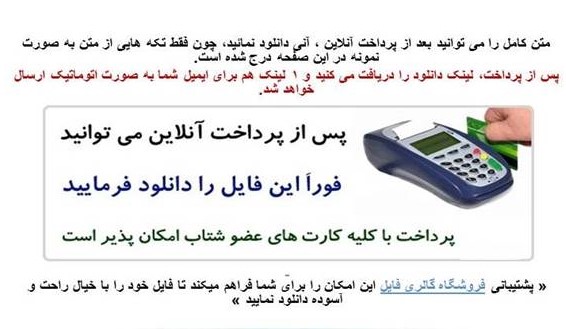لینک دانلود و خرید پایین توضیحات
فرمت فایل word و قابل ویرایش و پرینت
تعداد صفحات: 4
Public transport
From Wikipedia, the free encyclopedia
Jump to: navigation, search
"Mass transit" redirects here. For other uses, see Mass transit (disambiguation).
Bangkok Skytrain.
Contents
[hide]
1 In general
2 History
3 Modern public transport
3.1 Road
3.2 Rail
3.3 Water
3.4 Air
3.5 Sloped or vertical
3.6 Transport Interchanges
4 Public transport vs. cars in different countries
5 Environmental impact
6 Economic impact
7 Increase of Real Estate Value around transit stations
8 Funding
8.1 Hong Kong
8.2 United States
9 Ticket systems
9.1 Multi-use tickets
9.2 Electronic fare card
9.3 Free systems
9.4 Free travel pass
10 Transit-for-all
11 Social and Culture Issues
11.1 Food & drink
11.2 Noise
11.3 Safety
11.4 Sleeping
11.5 Smoking
11.6 Public Transport as Tourist Attractions
12 Emerging technologies
13 See also
14 References
15 External links
Public transport, public transportation, public transit or mass transit comprise all transport systems in which the passengers do not travel in their own vehicles. While the above terms are generally taken to include rail and bus services, wider definitions might include scheduled airline services, ferries, taxicab services etc. — any system that transports members of the general public. A further restriction that is sometimes applied is that transit should occur in continuously shared vehicles, which would exclude taxis that are not shared-ride taxis.
The term public transport is preferred in the British Isles and most Commonwealth countries, whereas public transportation, public transit or mass transit are used most often in North America. The term transit is less likely to include long-distance forms of public transportation, such as long-distance or commuter railroads, inter-city buses, or intercity railways.
Public transport is usually regulated as a common carrier and is usually configured to provide scheduled service on fixed routes on a non-reservation basis. The majority of transit passengers are traveling within a local area or region between their homes and places of employment, shopping, or schools.[citation needed]
[edit] In general
In many parts of the western world the private car currently dominates, however in major western urban areas with good public transport systems and where the private car ownership and use is discouraged, and also in the developing world, where private car ownership is prohibitively expensive, then walking, (motor)cycling, and public transport offer well-used alternatives. Many modern cities are investing in public transport initiatives to increase the attractiveness and usage of public transport. A popular transport mode in the developing world, and increasingly in the western world, is the share taxi (mini-bus, jitney etc) that run on flexible or semi-flexible routes.
Public transport can offer significant advantages in areas with higher population densities, due to its smaller physical and environmental footprint per rider and the problems associated with mass private car ownership and use (high parking charges and high levels of traffic congestion).
However, road-based public transport risks being considerably slower than private vehicles if it get held up in general traffic congestion and to compound this scheduled transport vehicles have to make frequent stops to board additional passengers and an individual trip may require one or more transfers. Transport Authorities wishing to increase the attractiveness and use of public transport often respond by increasing use of dedicated or semi-dedicated travel lanes (grade-separated, elevated, or depressed rights-of-way) and traffic light preempts and many other measures.
The term rapid transit, is often used to distinguish modes of transit possessing a dedicated right of way and having frequent, continuous service. Still, rapid transit often fails to live up to the name, as there are no firm guidelines as to how fast transit must be to be rapid.[1] Light rail is another form of public transit, comprising of a tram or trolley operating on a rail line.
[edit] History
Early trolley car in Newton, Massachusetts.
Conveyances for public hire are as old as the first ferries, and the earliest public transport was water transport, for on land people walked or rode an animal. This form of transport is part of Greek mythology — corpses in ancient Greece were always buried with a coin underneath their tongue to pay the ferryman Charon to take them to Hades.
Some historical forms of public transport are the stagecoach, traveling a fixed route from inn to inn, and the horse-drawn boat carrying paying passengers, which was a feature of canals from their 17th-century origins.
The omnibus, the first organized public transit system within a city, appears to have originated in Nantes, France, in 1826.
[edit] Modern public transport
Public transportation can usefully be classified in a variety of ways. Firstly by the required infrastructure (Road, rail, water and air). Alternatively by whether vehicles are used simultaneously by strangers (buses and trains) or not (taxi, car-hire, bicycle hire). Finally systems by the applicability of a fixed timetable or flexible routing and timing. In reality none of these classifications can be rigidly applied; there are vehicles that operate across different infrastructure (such as the guided bus), they are systems that are sometimes private and sometimes shared with strangers (various shared taxi services) and finally their are vehicles that run on semi-rigid timetables (some modern paratransit systems).

تحقیق درموردمتن انگلیسی حمل و نقل عمومی انگلیسی